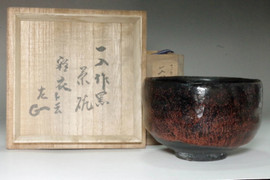4th Raku Ichinyu (1640-1696) Antique kuro-raku tea bowl #3970
- SKU:
- 3970
- Shipping:
- Free Shipping
- width: approx. 10.7cm (4 7⁄32in)
- height: approx. 7.3cm (2 7⁄8in)
- weight: 252g (gross 456g)
- writing on the box: Ichinyu made, writing by Seinyu.
- condition: small damaged
The Fourth Raku - Ichinyu (1640-1696)
Ichinyu’s wife was the daughter of the maki-e painter, Kumagaya Muneaki (Soukan), and they lived close to her family home for a time during the Kanbun era. For a while, he and his wife were unable to bear any children, but when he was 23 years old, they had a boy (Ichigen) and in addition, they adopted a boy (Sounyu) from Kariganeya Sanemon. After that, they had a daughter, Otsu (Myotsu), who later became Sounyu’s wife. There was a period of time when Ichigen was taken in by the Raku family, and there are also records of Ichigen and Sounyu accompanying Ichinyu to Ise where he had shine work as an onshi. In the 4th year of the Genroku era (1691), Sounyu received the family inheritance, shaved his head, and changed his name to Ichinyu. Ichigen left the Raku family and opened a Raku yaki kiln (later Tamamizu yaki) at his mother’s hometown in Yamashironokuni Tamamizu. In the 9th year of the Genroku era, Ichinyu died at the age of 57. Ichinyu was young when he took over the family name and he was influenced by his father, Dounyu. His powerful work was typically thin with large figures and has bold cuts such as recesses. However, in the later years, his style returned to a direction more like Chojiro. The dimensions of his tea bowls became small and the signature recesses were nowhere in sight. Of course, there were numerous standpoints from which to learn Chojiro’s style, which was the origin of Raku yaki, but it is thought that society’s trend at the time of returning to Rikyu was largely in the background of the return to Chojiro. The 3rd year of the Genroku era was the 100th anniversary of Rikyu, so the movement to re-examine Rikyu’s ideas and the Japanese tea ceremony became more active, and the desire for tools that Rikyu used became prominent. The times brought a return to Rikyu, and Chojiro’s tea bowls, which strongly drew from Rikyu’s ideas, must also have become desirable to people again. The red color of the “vermilion glaze”, a characteristic of Ichinyu’s representative glaze which appears as if it is floating up due to the coloring of the copper in the black glaze, has already been seen in Dounyu tea bowls, but Ichinyu was the first to complete it is as a glaze technique. In addition, compared to Dounyu’s abstract painting, Ichinyu was the one who started to paint more concretely. It is also said that Ichinyu was the one who began to write notes on the tea bowl boxes himself.




















